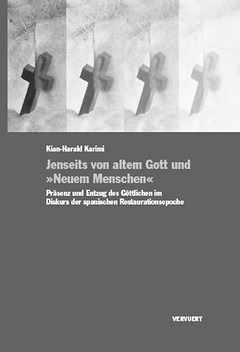



 |
 |
 |
 |
 |
 |
 |
 |
 |
 |
 |
 |
 |
 |
 |



 Sondereinband: 786 Seiten
Sondereinband: 786 Seiten
Verlag: Vervuert Verlagsges.;
Auflage: 1 (2007)
Sprache: Deutsch
ISBN-10: 3865273130
ISBN-13: 978-3865273130
Titelei und Inhaltsverzeichnis |

von Vernon A. Chamberlin in: Volumen doble 42/43 - 2007 Y 2008 - EN HONOR A PETER A. BLY.
Kian-Harald Karimi: Jenseits von altem Gott und "Neuem Menschen ": Präsenz und Entzug des Göttlichen im Diskurs der spanischen Restaurationsepoche. (Beyond the old God and the "New Man ": Presence and Withdrawal /Absence of the Divine in the Discourse of the Spanish Restoration Period). Frankfurt am Main: Vervuert Verlag, 2007. 785 pp.
The main divisions of this book are L "Einführung" (Introduction) II. "Seins -und sozialgeschichtliche Voraussetzungen des ontotheologischen Gottesbild" (Ontology -and Socio-Historical Assumptions of the Ontotheological Image of the Divine) III. "Textanalytischer Teil" (Text Analysis Part) IV. "Schlusskapitel" (Conclusion Chapter) V. "Bibliographie." A user-friendly Table of Contents further includes helpful subdivisions, which are too numerous to list here.
The purpose of the book is to show how the concept of and distance-relationship to the Divine changed during the period 1868-1898. The novelists of this period confirm the change that has been presented by Karimi with the aid of philosophical, historical, political, sociological, and artistic data. The purpose of the book is not to stimulate further research in the novels discussed, but rather to have them serve for further philosophical reflections.
The strength of the book consists of its meticulous, thorough, and up-to-date review of the body of critical work that has been done on the novels dealt with in the volume, and the ways Karimi links this critical overview to the changing concepts of the Divine and its earthly representatives.
Galdós receives 162 pages of continuous attention in the textual analyses, and additional references to him are scattered throughout the book. Unfortunately, these references are not designated by page number, making the task of finding them more difficult than need be for the reader. It would have been more helpful if instead of just "passim," there had been specific page numbers.
The two novelists whose works are analyzed in detail in Part III are Galdós and Valera. The novels that receive major focus there are Doña Perfecta, Marianela, El amigo Manso, La familia de León Roch, the La incógnita-Realidad pair, Miau, and Valera's Las ilusiones del doctor Faustino. Additionally Valera's Morsamor is examined as part of the conclusion. However, before arriving at any of these textual analyses, the author first takes us through more than 400, closely reasoned and heavily documented pages dealing with philosophy, history, politics, sociology, and the plastic arts, as he elucidates part of the second portion of the book's title: " The Presence and Withdrawl /Absence of the Divine."
Man's concept of God, Karimi reminds us, has evolved in many cultures, changing more in some than in others. In the West this evolution is reflected in many spheres, including philosophy and the visual arts. By the second half of the nineteenth-century, in some of the more progressive and industrialized parts of Europe, the concept and depiction of an all-powerful creator and judge had softened to a more benevolent, loving, and helpful God. Correspondingly, the concept of man changed also, now with less emphasis on his sinfulness and more on the possibility of progressive perfectibility of the individual, his family, and society. Pope Pius IX steadfastly resisted these new ideas, and he had more tenacious support in Spain than in some other Catholic countries. In Spain, of all the contemporary novelists, it was Galdós who took up the challenge of defending the new concepts, which owed much to the philosophy of Karl Christian Friedrich Krause, as publicized by Julián Sanz del Río.
Influenced by Michel Foucault's "Place of the King," Karimi emphasizes an additional change related to the monarch. The latter had been, in many societies, the intermediary between God and man. Thus in Spanish Golden Age drama the King comes forth only to provide the denouement by solving the main conflict. However, as views of the Divine changed, so too the perception of his intermediary. with this change being accelerated by such events as the French Revolution, the Constitución de Cádiz, and the abdications of Isabel II and Amadeo I. Moreover, during the 1873-74 Primera República, there was, of course, no sovereign at all -until the Bourbon Restoration, with a constitutional monarch. Importantly, Karimi chooses to present the first four of his textual analyses under the general rubric "Der Figur des Königs als Subjekt des Gottessignificanten" (The Figure of the King as Subject of the Divinely Signified), with further qualifying specifications for each novel discussed.
In "Doña Perfecta and die misslungende Reterritorializierung des aufklärerischpositivistichen Denkens" (Doña Perfecta and the failed Reterritorialization of Enlightenment-Positivistic Thought), Karimi shows us how the King comes forth in the "dürftige Zeit" (the time of need). Now no longer a representative of the "Old Divinity," the protagonist's Kingship is communicated by his surname "Rey," and abundant Christological imagery. Moreover, he is now not simply the monarch, but a more complex character incarnating also aspects of the "New Man,"-one who strongly evidences characteristics of both Krausista idealism and Comtian Positivism. Not only does he not represent the "Old Divinity;" but he must contend with the latter's representatives on earth; and, as every reader of Doña Perfecta knows, he is destroyed by them. This is all well and good, except for one minor point: the notion that María Remedios is suggestive of Mary Magdalene, Because of her constant sighing and lamenting, she is better viewed as an aggressive parody by Galdós of the Virgin Mary- "Nuestra Señora de los Suspiros,"-lamenting the fate of her son Jesus. Here Galdós is responding to Pius IX's repeated invocation of the Virgin in his tenacious struggle against liberal ideas, as the Pontiff all the while insists that the Church is a "societas perfecta."
The motif of the King coming forth in an attempt to solve human problems is continued in Karrnini's section entitled "Marianela and die sokratische Suche nach der Erkenntnis" (Marianela and the Socratic Search for Knowledge). The King helps advance mankind along the Comtian trajectory to Positivism, but destroys the beauty of the mythological stage as embodied by Marianela. Leonine imagery designates Dr. Golfín as the King figure. In "El amigo Manso zwischen der Harmonie des Geistes and den Unstimmigkeiten der Immanenz" (El amigo Manso between Harmony of the Spirit and the Inconsistencies of the Immanence), we see, in contrast to Golfín and Pepe Rey, who clearly have some King-like function, Manso as a professor of philosophy, whose opening remark, "Yo no existo," creates uncertainties that prevent him from being the sovereign of his own discourse, In "La famila de León Roch: Die bürgerliche Familie als Sinnbild gesellschaftlicher Repräsentation and ihre Auflösung" (The Bourgeois Family as Symbol of Societal Representation and its Dissolution), the King figure reappears and, as in the case of Dr. Golfín, again with leonine evocations. The main marker is now the protagonist's given name: León. He is in this novel a complex character, showing not only aspects of Kingship, and the Divine, but very importantly also those of the "New Man," who once again incarnates aspects of Krausian idealism and Comtian Pragmatism. Representatives of the "Old God," with their intransigence, religious fanaticism, and clerical interference in marital life prevent the protagonist from having any sovereignty in his own family. Since no compromise is possible between the two contending forces, an attempt to create new social structures must be undertaken, as illustrated by León's creating a new home, where he can validate his own beliefs and aspirations, while also enjoying the company of Pepa Fúcar and her daughter, Monina.
The final three of the major analyses are considered under the heading "Der König and die Vielfalt der Zeichen" (The King and Variety of the Signs). In the first of these, "La incognita and Realidad : von 'Infanten' der Repräsentation zum Verlust des auktorialen Erzählers" (From Crown Prince of Representation to the Loss of the Authorial Narrator) , the figure of the King has been replaced by the Crown Prince. Instead of Doña Perfecta's Pepe Rey, there is Manuel Infante, who in no way enjoys royal power, but rather serves within the parliamentary government of the Cortes, where he makes no positive contribution. In "Der Bruch des göttlichen Zeichens am Beispiel von Miau" (Rupture of the Sign of the Divine in the Example of Miau) one sees a fictional demonstration of the initial part of the book's subtitle, "The Presence and Withdrawl/ Absence of the Divine." Frightened by contemporary religious art, the child Luisito Cadalso creates his own God, a Divinity with whom he can converse, and receive consolation concerning his everyday problems. At the other end of the spectrum his grandfather experiences the absence of God, as he receives no help with his earthy travails, leading him to have no fear of the sin of suicide-as he ironically rises to have aspects of Kingship through the "Miau" motif, which he comes to accept as his INRI.
In Valera's 1875 "Las ilusiones del doctor Faustino: Die Erwartung einer apriorischen Sinngebung und die Leere der Signifikanten" (The Expectation of an Apriorital Symbol Communication and the Emptiness of the Signifieds), the King figure, Karimi affirms, is incarnated in the character Juan Fresco, who, after extensive experiences and travel, can no longer believe in the Divinity as represented in the artistic depictions of his childhood. On the other hand, Valera's Faustino, in accord with his name, is a small-scale reincarnation of Goethe's Faust, but now one who has no Mephistopheles to help him attain earthly goals and satisfactions. Consequently, he commits suicide. Only In Valera's Morsamor (1899), when Spain is profoundly shaken by military defeat and loss of empire, may one perceive a possible solution to the problems presented in the seven previous novels. In Morsamor the eponymous protagonist travels in a dream to India, a place where there are completely different religious concepts-some of which might be helpful in the Occident.
In spite of this book's being written (and marketed) primarily for the theological and philosophically minded, there are indeed interesting new ways presented for looking at the Spanish Realist novel of the last quarter of the nineteenth century. Therefore, one hopes that a Spanish-language translation, or at least a republication of the present volume's textual analyses section with a new, shorter introduction could appear in the future. Until such a time, galdosistas may wish to consult an earlier contribution by Prof. Karimi (University of Bonn): `El cuadro soñador se queda atrás.' La riqueza de lo divino en la pobreza del ser a través de los ejemplos narrativos de Clarín, Pérez Galdós and Valera." Estrategias narrativas y construcciones de una 'realidad.' Lecturas de las novelas contemporáneas de Galdós y otras novelas de la época. Eds. Stenzel, Hartmut y Friedrich Wolfzettel. Las Palmas: Ediciones del Cabildo Insular de Gran Canaria, 2003.










